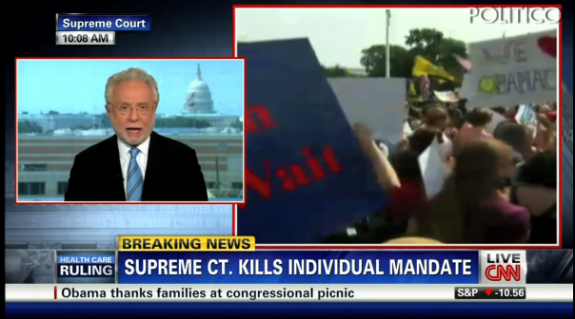
I love process stories, pieces that take us behind the scenes of an event to tell us what happened in real time from the people who were part of it. The best one I’ve read in a long time is Tom Goldstein’s report on the media’s coverage of the Supreme Court decision on ObamaCare 12 days ago. Tom is the top guy at ScotusBlog, whose reporting team was an invaluable resource to anyone who wanted to know what the court said as the decision was handed down.
In his report, Goldstein delves deeply into why CNN and Fox initially got the decision wrong, while other media outlets were more patient and concerned about accuracy than being first. He breaks down those first ten minutes with insider information about how his ScotusBlog team analyzed the complexities of the decision quickly, how CNN’s well-connected social media team exacerbated the problem by immediately distributing the network’s incorrect information on other platforms, how Bloomberg News beat everyone in reporting it right, and how Obama’s staff in the White House had to figure out what was going on without access to the actual decision because the Court’s website had crashed from too much demand.
At the White House, the President of the United States has stepped out of his daily briefing into an adjacent room where he can see CNN and Fox News. He is about to learn the fate of a law that he believes is essential to the health care of millions of Americans, for which the Administration has sacrificed many other priorities, and which could be essential to his re-election. As he sees the banners flash across the bottom of the screens, it looks very, very bad.
In Press Secretary Jay Carney’s office, the communications team has three principal sources of information: monitors showing the cable networks; our conference call on speakerphone; and our Live Blog on the computer.
The announcements on CNN and Fox News in Carney’s office have been the first news of the decision, and both report that the mandate had been invalidated. Although the wire services have already reported the decision correctly, the communications team is not aware of those reports.
The staff goes quiet, but it does not lose hope. On the conference call, I had said that the Administration had lost the Commerce Clause argument, but that there was more to the decision and that it was complicated. So they continue to listen to the call, and to watch the Live Blog. Waiting for further word, they do not send out an email even to the working group of the communications and Counsel’s Office teams. And they do not move to tell the President, unaware that he is watching the incorrect television reports.
It’s a must-read piece — particularly for anyone in the media who still hasn’t learned that no one remembers who did it first, but everyone remembers who got it wrong.
